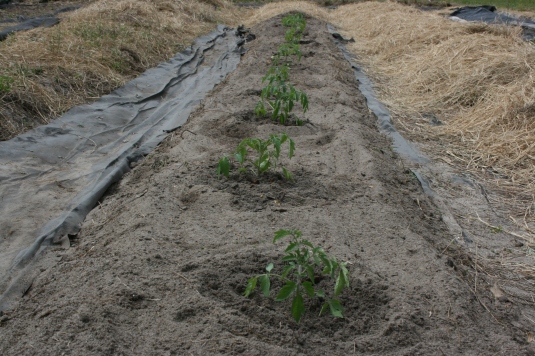Are we lucky to live in Florida, or what?
Sure, I run the risk of one last freeze. Happens every year. Nearly. But maybe I’ll be spared this spring. After all, Mother Nature tortured me in December… Do you think she could be so cruel?
Nah, me neither. She’s an all right gal. So what if I don’t agree with her sense of humor, or her downright obstinate ways when it comes to wielding her power, but she has been good to me. Overall, I can’t complain. (Are you listening, Mrs. N? I’m the good one!)
So out the door these sproutlings went, straight into the garden. I started them early January and yes, I did have to drag them inside a few times and spot them a sweet place by the warm and blazing hearth. But just look how they’ve rewarded me. Aren’t they grand? Real beauties. My kids helped clear the row of hay and I tilled the section with ease.
Once you know the secrets of preparation this part is EASY. Then, I gingerly pulled each out and placed it into a hole amended with a mixture of my very own compost (AKA homemade dirt), epsom salt and eggshells. Brilliant. And the key to eliminating blossom-end rot. I hope. Formed a well around my babies and watered them in. Finito. Easy as tomato pie.
Mud pie. I meant mud pie. Last time I tried to make an authentic Italian tomato pie for my husband, things didn’t go very smoothly. Time-consuming, irritating… It was the crust that gave me issue. And my handy-dandy Cuisinart contraption that promised to do the hard mixing did nothing of the kind!
False advertising, if you ask me. But I digress–into the land of disappointment (where I do not care to dwell). My tomatoes are in! Who has time to weep?
I have a watering schedule to attend, fertilization needs to consider… And companions. Who shall I plant next door?
If you think I haven’t already arranged for that play over in my excel program, you’re kidding yourself. What else do you do during winter? Besides scour the seed magazines and drool over the gorgeous photos and plethora of produce.
Beats Christmas shopping.















Thanks for your comments!